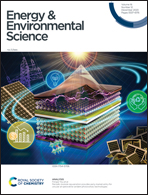Regulating and identifying the structures of PdAu alloys with splendid oxygen reduction activity for rechargeable zinc–air batteries†
Abstract
Alloying improves catalytic performance, but the control is challenging due to element contributions. Here, we study the structural differences in PdxAuy alloys to understand their impact on the oxygen reduction reaction activity. Spectroscopic and theoretical analyses reveal ensemble and ligand effects induced by alloying. We observe that active adjacent Pd sites become inactive isolated Pd sites upon dilution with Au due to the ensemble effect. As the Au proportion increases, the Pd d-band is progressively filled due to charge hybridization from the ligand effect. The optimized coordinate and electronic structures result in reduced energy barriers and enhanced reaction kinetics in PdxAuy catalysts. Remarkably, the optimal Pd55Au45 catalyst achieves a mass activity of 962.59 A gPd−1 at 0.9 V versus reversible hydrogen electrode, approximately 15 times higher than that of commercial 20 wt% Pt/C. Zn–air batteries with a Pd55Au45 cathode exhibit remarkable specific capacity and 2000 hour stability. This study provides valuable insights into the rational regulation and catalytic chemistry of alloys.



 Please wait while we load your content...
Please wait while we load your content...